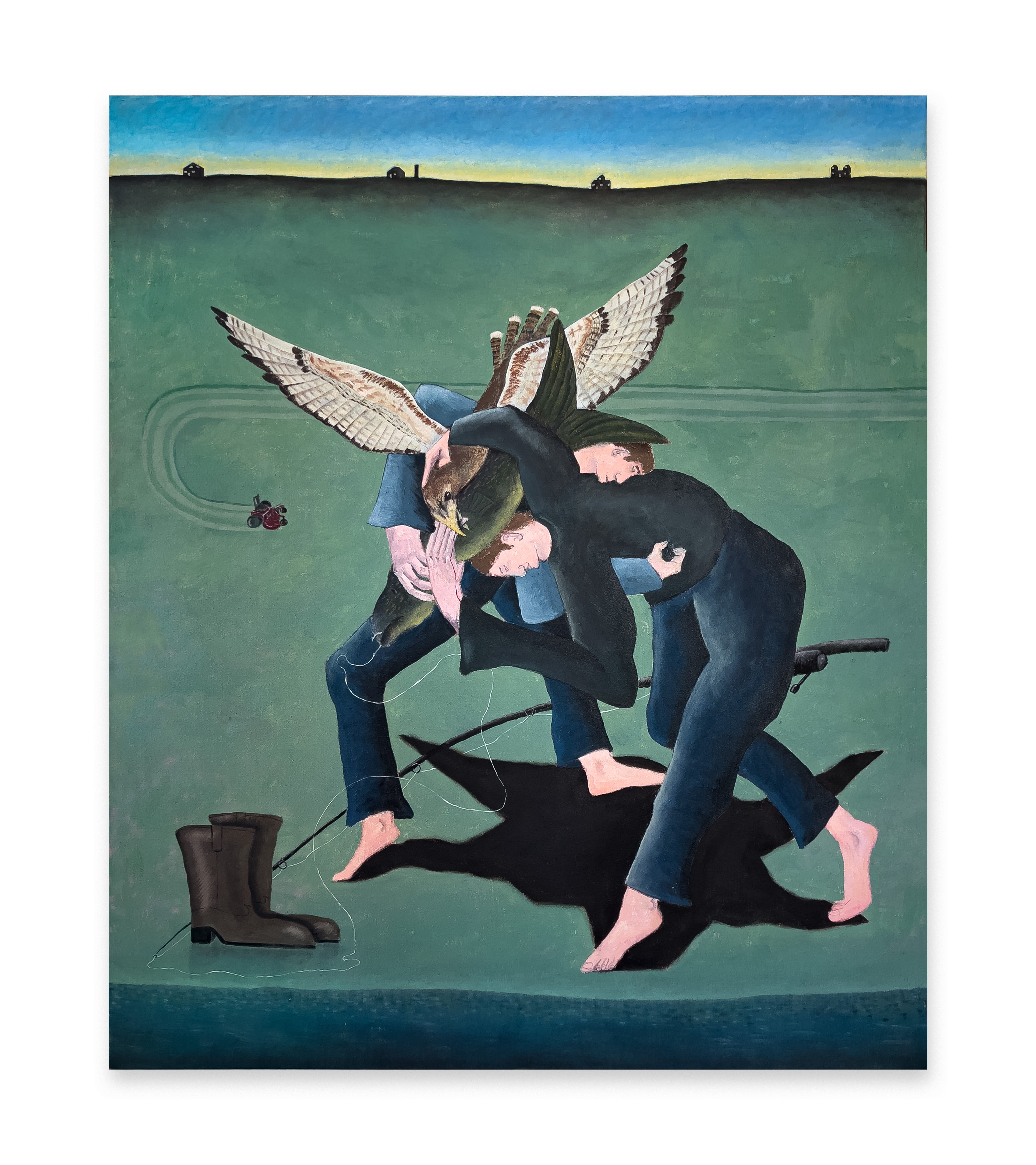
William Schaeuble, “Fishermen Wrestling Animals,” 2024, oil on canvas, 50″ x 42″/Photo: Povos gallery
At first glance, William Schaeuble’s paintings in his current show at Povos gallery appear to be visual equivalents of the knock-knock joke: sparse in content, but reliable for a short bit of fun. One can imagine my surprise, then, when I found that beyond their jocular surfaces lies a void of heartfelt introspection—introspection that, in typical Midwestern fashion, is more banal than it is poignant. That Schaeuble manages to engage in earnest self-reflection through pictures so patently ridiculous is nothing short of a miracle.
Schaeuble fits effortlessly into the greater scheme of Americana’s visual dramatists, inheriting as a staging ground the melting Midwestern hills of Thomas Hart Benton and Grant Wood. What is painted upon this tabula rasa is informed to some degree by painters Eric Fischl and David Salle, whose virtuosic ability to pit everyday life against itself is artfully cribbed by Schaeuble. (If I could draw a family tree for Schaeuble, Fischl and Salle would be his two older brothers, who owe their greater success—thus far, at least—to shamelessness and narcissism, respectively. Other notable relatives would include tortured grandfather Philip Guston, doting grandmother Alice Neel and estranged uncle Edward Hopper, whose fiery tongue is made up for only by his ability to make time stop on a dime.) The show’s title—”Fights”—seems more like a leaping-off point for each painting rather than a retroactively imposed thematic similarity. Schaeuble leaves no stone unturned, plumbing the depths of the theme’s connotations.

William Schaeuble, “Missing the Best Part (Theater Fight),” 2024, Oil on canvas, 30″ x 24″/Photo: Povos gallery
In many works here, fighting is explored as a purely aesthetic activity: take “Fishermen Wrestling Animals,” which depicts the bodies of two blue-clad men entangled with an oversized fish and an imperious hawk. The heterogenous ball of limbs and bodies at its center is transfixing—one of the men enacts an elegant contrapposto, whose one-sidedness contrasts beautifully with the hawk’s balanced spread-eagle position. You get the sense that an alien—someone completely unfamiliar with the physical phenomena being depicted—would find this precise arrangement of color and form quite appealing.
Yet Schaeuble’s explorations of fighting’s allure can never stay in the strictly formal realm: before long, he finds himself dissecting the peripheral subject of masculinity. In “Missing the Best Part (Theater Fight)”—a work in which David Salle’s influence is palpable—one man throws a jab at another in a populous movie theater while a racy motion picture plays in the background. The man’s punch is so perfectly placed that his outstretched arm covers the exposed breasts of a naked woman on-screen. What’s happening here? Did the motion picture somehow cause this brawl? Is it possible that restrictive conceptions of femininity (like those depicted in the fictional film: that to be feminine is to be sexy, submissive, slim) create equally restrictive ideas of masculinity (thus the sudden eruption of violence among men in the audience)? I’m inclined to say yes. That Schaeuble has us asking such questions is a testament to his economic facture.

William Schaeuble, “The Schaeuble Brothers Wrestling,” 2024, oil on canvas, 40″ x 32″/Photo: Povos gallery
Other times, Schaeuble approaches masculinity quite personally. His “The Schaeuble Brothers Wrestling” centers on a tangle of the three brawny title figures. Despite the picture’s abject violence—occasionally, each figure achieves a level of fearsomeness comparable to that of St. Matthew’s attacker in his eponymous Caravaggio trilogy—a circle of three daintily dancing cats in the corner of the picture belies that the brothers are engaging in a ritualistic act of bonding. Schaeuble seems to meditate on this act in his “Portrait of the Artist’s Younger Brother,” a front-on depiction of the title’s prim and proper young man, above whom two ungainly figures trade blows. A pungent sense of impropriety pervades the image, as if Schaeuble and his brother can’t reconcile their responsible adult selves with the belligerent teenagers who fortified their relationship through intimate physical battles. Why there’s any kind of connection between these brawls and the brothers’ relationship is unclear, but anyone who was once a young man can tell you the link is there. That’s Schaeuble’s magic. He unearths shared truths and asks a simple but revelatory question: Why? You’ll be too nonplussed to articulate a rejoinder.
William Schaeuble’s “Fights” is on view at Povos gallery (West Town), 1541 West Chicago, through July 27.


